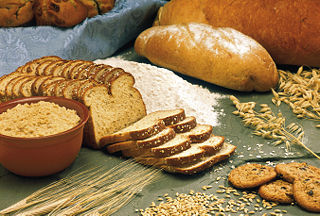
A cereal is any grass cultivated (grown) for the edible components of its grain, composed of the endosperm, germ, and bran. The term may also refer to the resulting grain itself. Cereal grain crops are grown in greater quantities and provide more food energy worldwide than any other type of crop and are therefore staple crops. Edible grains from other plant families, such as buckwheat (Polygonaceae), quinoa (Amaranthaceae) and chia (Lamiaceae), are referred to as pseudocereals.

Aquatic plants are plants that have adapted to living in aquatic environments. They are also referred to as hydrophytes or macrophytes to distinguish them from algae and other microphytes. A macrophyte is a plant that grows in or near water and is either emergent, submergent, or floating. In lakes and rivers macrophytes provide cover for fish, substrate for aquatic invertebrates, produce oxygen, and act as food for some fish and wildlife.

The Wet Tropics of Queensland World Heritage Site consists of approximately 8,940 km2 of Australian wet tropical forests growing along the north-east Queensland portion of the Great Dividing Range. The Wet Tropics of Queensland meets all four of the criteria for natural heritage for selection as a World Heritage Site. World Heritage status was declared in 1988, and on 21 May 2007 the Wet Tropics were added to the Australian National Heritage List.

Ludwigia is a genus of about 82 species of aquatic plants native to Central and South America with a cosmopolitan but mainly tropical distribution.

Uncle Ben's is an American brand of parboiled rice and other related food products that was introduced by Converted Rice Inc., which is now owned by Mars, Inc. Its headquarters are in Denver Harbor, Houston, Texas. Uncle Ben's rice was first marketed in 1943 and was the top-selling rice in the United States from 1950 until the 1990s. In 2020, Mars declared that the brand would be changed to "Ben's Original". The brand's products are sold worldwide.
George Don was a Scottish botanist and plant collector.

Cuphea hyssopifolia, the false heather, Mexican heather, Hawaiian heather or elfin herb, is a small evergreen shrub native to Mexico, Guatemala and Honduras.
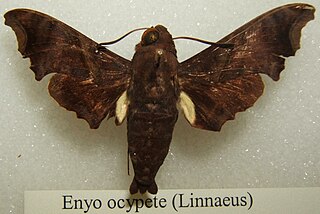
Enyo ocypete is a moth of the family Sphingidae. The species was first described by Carl Linnaeus in his 1758 10th edition of Systema Naturae. It is found from the southern United States, through Central America to Venezuela, Brazil, Peru, Bolivia, Paraguay and northern Argentina.
Gentianella hyssopifolia is a species of plant in the Gentianaceae family. It is endemic to Ecuador. Its natural habitats are subtropical or tropical high-altitude shrubland and subtropical or tropical high-altitude grassland.

Tropical horticulture is a branch of horticulture that studies and cultivates plants in the tropics, i.e., the equatorial regions of the world. The field is sometimes known by the portmanteau "TropHort".
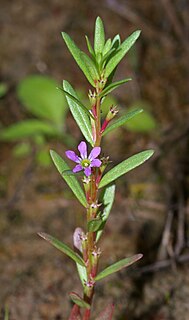
Lythrum hyssopifolia is a species of flowering plant in the loosestrife family known by the common names hyssop loosestrife and grass-poly. It is native to Europe but it is known elsewhere, including parts of Australia and eastern and western North America, as an introduced species and sometimes a weed. It is rare in the United Kingdom, with occasional isolated populations. It often grows in moist habitats, such as marshes and wet agricultural fields, rice paddies, for example.

Bassia hyssopifolia is a species of flowering plant in the family Amaranthaceae, known by the common names five-horn smotherweed, five-hook bassia, and thorn orache. It is native to parts of Asia and Eastern Europe, and it is known on other continents as an introduced species, including North and South America and Australia. It is a weed, invasive at times.

Ludwigia adscendens, the water primrose, is a species of flowering plant in the evening primrose family. Its native distribution is unclear. It is now a common weed of rice paddies in Asia and occurs also in Australia and Africa, but may have originated in South America.
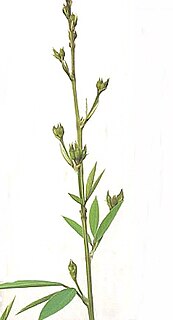
The pigeon pea, also known as pigeonpea, red gram, tur, pwa kongo in Haiti, guandú and frijol de palo in Ibero-America, gungo peas in Jamaica, or as adua by the Dagomba people of northern Ghana, is a perennial legume from the family Fabaceae. Since its domestication in the Indian subcontinent at least 3,500 years ago, its seeds have become a common food in Asia, Africa, and Latin America. It is consumed on a large scale in South Asia and is a major source of protein for the population of the Indian subcontinent. It is the primary accompaniment to rice or roti and has the status of staple food throughout the length and breadth of India.
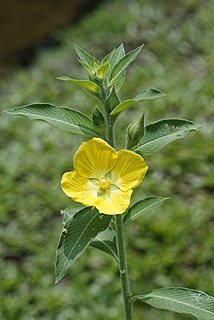
Ludwigia peruviana, with the common names Peruvian primrose-willow or Peruvian water primrose, is an aquatic, sometimes deciduous species of flowering plant in the evening primrose family. It can grow to approximately 12 feet (3.7 m) in height. While native to Peru, it has been introduced in many other countries for its attractive simple yellow flowers, it is now a common weed in swampy areas around the world.

Ludwigia grandiflora is an aquatic plant of the order Myrtales.

Sphenoclea zeylanica, called chickenspike, gooseweed, and wedgewort, is a widespread species of flowering plant in the genus Sphenoclea, native to Africa, Madagascar, tropical and subtropical Asia, and Australia. It is widely introduced in the New World tropics and subtopics from the southern United States to northern Argentina. Its young leaves are edible and are occasionally eaten, perhaps with a light boiling. A common weed of rice paddies, it can cause yield losses from 25 to 50%.

Cleome spinosa, called the spiny spider flower, is a species of flowering plant in the genus Cleome, native to the New World Tropics, and introduced to the United States, tropical Africa, the Indian Subcontinent, Vietnam, New Caledonia, and Korea. It is pollinated by bats.

















